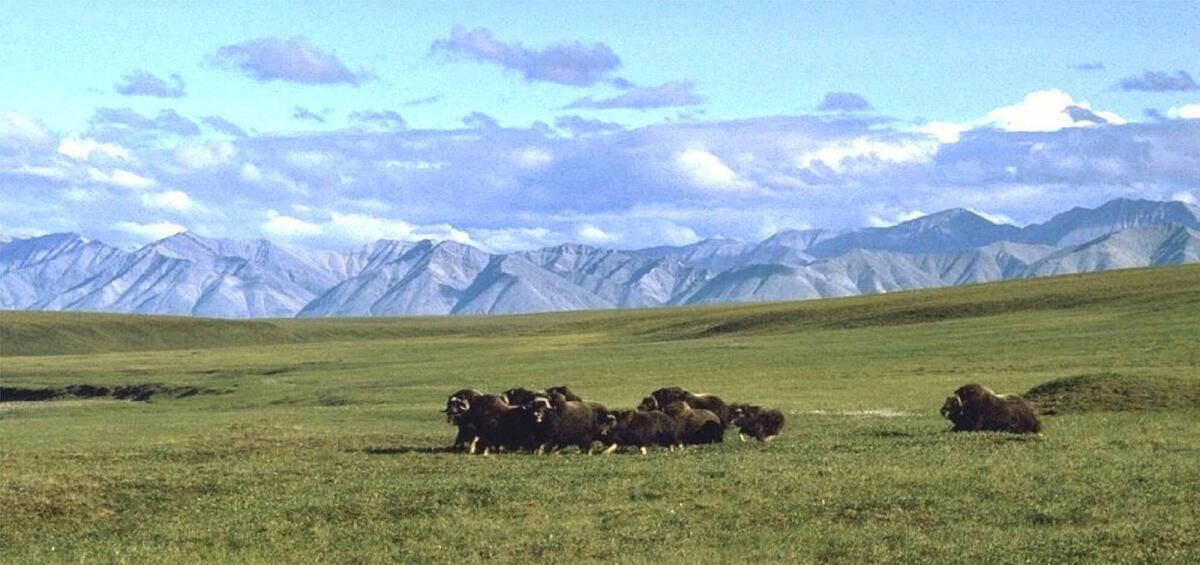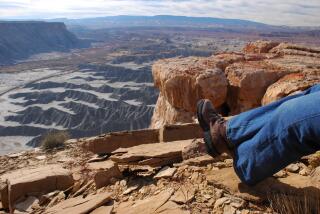Op-Ed: Who will clean up Alaska’s ‘orphaned’ oil infrastructure?

- Share via
You can feel the encroaching decay in the sides of buildings, in the limp remains of a once-proud drill rig slowly rusting into the waterlogged gravel and tundra. In the 1950s, one of us, George, was part of the expedition that explored and then advocated for the formation of the Arctic National Wildlife Refuge. At that time, he worried the region would end up resembling the disrupted skylines and greasy sheens of Texas’s aging and abandoned oil fields.
More recently, we visited the sprawling spaghetti of pipelines, metallic shells of buildings and this defunct drill rig, now worrying that a legal and regulatory morass will bring George’s dystopian fears to fruition. There has been little formal preparation for what happens when oil ends, even as the Trump administration has announced plans to fast-track the auction of leases for drilling in pristine areas of the Arctic refuge, with similar plans for parts of the Teshekpuk Lake Special Area in the National Petroleum Reserve-Alaska.
If we ignore the costs for plugging and abandoning wells, dismantling and removing accompanying infrastructure, and fully restoring impacted tundra, we allow for a vast overestimate of the economic value of oil in these outstanding Arctic ecosystems. Unless the intent is to walk away and just leave the mess behind.
For generations, people arriving in Alaska have done just this. Alaska’s legacy of abandoned infrastructure and contaminants has wrought havoc on numerous remote sites, and for many communities. In our travels across the Arctic coastal plain, we encountered abandoned drill sites where metal shards and sun-bleached wood punctuate rotting gravel pads, the acrid smells a clear olfactory reminder of what should not be there.
In the absence of plugging and proper abandonment, fluids and gases left in wells and underground reservoirs can seep to the surface. Added to this chronic challenge are corrosion of well bores from salts and water, the settling of land and changes in the climate that contribute to erosion of the hard surface permafrost.
In a few decades, the bulk of revenues from Alaska’s North Slope will be dispersed, and this decaying industrial mess will be someone else’s problem, if it is dealt with at all.
The Government Accountability Office stated in 2002 that there were inadequacies in planning for the proper and effective cleanup of abandoned sites on the North Slope of Alaska. The GAO restated its concerns in 2003, 2010 and 2011. The Department of the Interior Inspector General in 2015 and the Congressional Research Service in 2018 echoed these concerns.
Trump’s rush to sell drilling leases in the Arctic National Wildlife Refuge brings to fruition a huge congressional mistake that could add to global warming.
Other large oil fields, such as in Texas, Louisiana and California, do not offer much solace as the number of their “orphaned” wells grow. In Louisiana, there are over 4,000 abandoned and unplugged wells, many of them in deteriorating condition. Texas has over 6,000, and California another 5,500, that are abandoned or at high risk of becoming so. Thousands of inactive additional wells will likely add to these numbers as the years tick by.
The decline in oil prices since 2014 has exacerbated the trend of well abandonment, particularly among smaller operators who may also be facing bankruptcy. These declines further reduce the already-inadequate revenues allocated to cleanup funds for these abandoned sites.
Alaska is starting to experience these pressures. The bankruptcy of Aurora Gas in 2018 left the state the responsible party for cleaning up three wells on state land. Recent news that BP is closing shop in Alaska and selling to the smaller Hilcorp is consistent with this trajectory.
Decommissioning costs cannot be an afterthought. The Bureau of Land Management spent $90 million in northern Alaska, remediating just 18 of 136 “legacy wells” that the federal government drilled between 1944 and 1981. On Alaska’s North Slope, cleanup of a 60-acre oil-field logistics site ran up a $2-million bill and is still not complete. There are now over 3,000 active wells on the North Slope and another 800 suspended or idle, linked by a labyrinth of pipes, buildings and gravel roads.
Current bonding levels, the funds put aside by the industry to ensure adequate decommissioning of wells and other infrastructure, barely touch what’s needed for cleaning up what’s been built or drilled to date. Former State Commissioner Cathy Foerster previously expressed doubt that the bonds would “even pay for the engineering study needed to plan the plugging operations, much less any of the actual plugging costs” — and these plugging costs are just one small component of cleaning up the accumulated debris of a specific drill site, never mind the new oil fields that continue to sprawl outward from the Prudhoe Bay hub. Operators can hold blanket bonds for their entire operations that may not even cover a single site’s cleanup.
There has been reticence from the industry and regulators to absorb the burdens of decommissioning at the outset. However, if the state of Alaska or other local representatives do not insist on a bond to cover all costs of potential cleanup and restoration prior to approval of an operation, experience in North America and around the world strongly suggests it will not be done.
If we cannot afford a plan to fully clean up and restore an area, this is just one more of the many reasons why we cannot afford to drill new wells.
George Schaller is a senior conservationist at the Wildlife Conservation Society. Martin Robards is regional director for the Arctic Beringia program at WCS.
More to Read
A cure for the common opinion
Get thought-provoking perspectives with our weekly newsletter.
You may occasionally receive promotional content from the Los Angeles Times.










